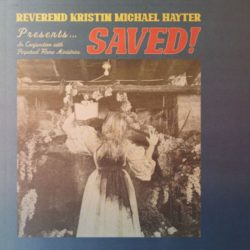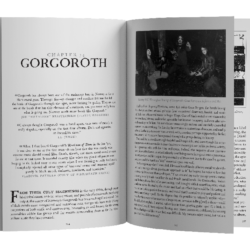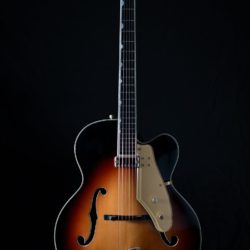
ALBUM REVIEW: SAVED! – Reverend Kristin Michael Hayter
KRISTIN HAYTER, the artist formerly known as LINGUA IGNOTA, first rose to prominence with her unflinching, harrowing albums under the moniker that dealt with abuse and trauma she had experienced….
Read more »
Stompboxtober 2023 Day #17 – Daredevil Pedals
Today’s giveaway is coming to you from our friends at Daredevil Pedals. Enter here for your chance to WIN a Ltd. Edition Wolf Deluxe Fuzz!Stompboxtober 2023 Day 17 – Daredevil Pedals
Daredevil Pedals Ltd. Edition Wolf Deluxe Fuzz – Blue/WhiteThis is a hand wired, limited edition Wolf Deluxe Fuzz by Daredevil Pedals. 1 of only 12 released in the White & Blue finish, all built in Chicago.The Wolf Deluxe circuit is Johnny’s modified take on the Silicon Fuzz Face, originally release way back in 2013. These have a more defined low end, more midrange honk, and an incredible amount of sustain and crunchy fuzz rasp.

Dayal Patterson: On the New Edition of “Black Metal: Evolution of the Cult”
Author Dayal Patterson discusses the massive 800-page reworking of his black metal history reimagined as Black Metal: Evolution of the Cult — Restored, Expanded & Definitive Edition.
The post Dayal Patterson: On the New Edition of “Black Metal: Evolution of the Cult” appeared first on Decibel Magazine.

“It wouldn’t have worked with the Stones at all. We’re all about teamwork”: Jeff Beck was once rumored to join The Rolling Stones – Keith Richards explains why that never happened
Although the two parties never aligned, their mutual respect for each other was clear: “He was one of the best, man,” Richards tells Guitar Player
Read more »
“I got into ES-style guitars because of that scene in Back to the Future!”: How Chris Stapleton, the humble capo and Marty McFly shaped Ashley Sherlock’s breakthrough debut album
The Gibson artist discusses the guitars, approaches and songwriting philosophies that informed his debut record, Just A Name
Read more »
J. Rockett HRM V2 review: a beautifully voiced Dumble-style drive pedal of the sort that encourages you to keep playing
With its latest HRM V2 pedal, J. Rockett refines the Hot Rubber Monkey-modded Dumble sound
Read more »
Watch: VINCE NEIL Makes Surprise Appearance At SAMMY HAGAR’s Birthday Celebration In Cabo San Lucas
Rock And Roll Hall Of Famer Sammy Hagar returned to Baja last week to celebrate his legendary Birthday Bash with three epic nights of performances featuring his Billboard chart-topping group THE CIRCLE at Cabo Wabo Cantina. Plus, as a special gift to the fans who couldn’t be in Baja, Hagar’s award-w…
Read more »
A Lesson Learned from a ’50s Gretsch
Here at Fanny’s House of Music, there’s a lot of virtues we hold dear. We try to be kind to everyone, and treat folks the same regardless of their experience level. But if I had to pick a character trait Fanny’s values most highly, it would be a willingness to learn. Possessing a willingness to learn means infinite potential. It means you can be anything you want to be if you try. It also means humility. Saying, “I don’t know the answer, but I’ll try to find out for you,” tells folks you respect them enough to not make stuff up. There’s a lot of power in admitting you don’t know everything.If you didn’t know everything in the guitar business in the early to mid 1900s, you were in good company—as so much was only just emerging. In 1936, Charlie Christian ripped open a can of electrical worms when he used his “pick-up unit” to soar over his otherwise acoustic band, establishing the guitar as a solo instrument and touching off a phenomenon in guitar manufacturing. Then, in 1948, Fred Gretsch Jr. returned to the helm at Gretsch—having briefly managed the company in the early ’40s—with a bold new vision that would meet the demands of guitarists wanting to plug in and turn up.Gretsch began offering exciting custom finishes and all manner of gadgetry and gizmos, but not every guitarist was ready to take the electric plunge. They needed a guitar for the electric skeptic. So, in 1955, the Model 6199 “Convertible” was introduced. “Play it electric or play it acoustic and get top tone either way,” extols the 1955 Gretsch catalog. “That’s because instead of being built-in, the Gretsch Dynasonic pickup of this guitar is suspended clear of the top to allow full, free vibration.”But, as is so often the case when one tries to be all things to all people, the Convertible was not a big seller. It did, however, attract the attention of prominent jazz guitarist Sal Salvador, pictured proudly with his sunburst Convertible on his album covers. Salvador was a capable performer who valued a willingness to learn, teaching many students privately in New York at the height of his musical popularity.“If you didn’t know everything in the guitar business in the 1950s, you were in good company.”In 1956, one of Salvador’s students, 24-year-old Dan Duffy, was hired to oversee quality control at Gretsch. He wrote a book about his experience called Inside the Gretsch Factory 1957/1970. I managed to track down a copy, and found it written in all caps. I delighted myself in imagining Duffy shouting the entire book to someone. It’s really a fun little book. In it, Duffy describes the Convertible as a “good guitar” that had “a great sound but was prone to feedback.”Duffy had his own learning experience trying to fix this problem. Installing soundposts had a minimal effect, so Duffy decided—in all his 24-year-old wisdom—to stuff it with fiberglass and test it out on a gig. “That night, I shook more than Elvis did,” writes Duffy. “Somehow I got it down my neck and was jumping out of my pants all night…. I brought it to work. I put the air pressure hose inside the guitar and blew it out. The next day, some of the workers complained they had a terrible itch all night. I said, ‘Me, too.’ I knew this was stupid when I was doing it.”By 1958, when the dust of Duffy’s debacle had settled, the Convertible had become so closely associated with Salvador that Gretsch just went ahead and renamed it the Sal Salvador model. Which brings us to ours: a 1961 Sal Salvador model in great cosmetic condition. It has obviously been well taken care of and is all original. Its remarkable acoustic projection does in fact make it a great choice for someone wanting to switch between plugged and unplugged jazz playing. The inviting C-shape neck feels comfy and the action is 2/32″ on the low side and 1/32″ (!) on the high side. Playing this guitar feels a little like floating on air.One could easily engage with guitars only on this surface level: assessing the neck angle, the scale length, the condition of the finish, et cetera. But digging a little deeper and indulging our desire to learn guided us on a journey: from the earliest days of amplified instruments to the fine old jazz box laying in my lap today. Here’s hoping these guitars keep passing through our doors and telling us their stories, as long as we are willing to listen.
Read more »
ALBUM REVIEW: Ausdauer – Bismut
Right in the heart of the Netherlands lies the province of Gelderland, which is home to the city of Nijmegen. It is one of the oldest cities in the Netherlands,…
Read more »
Meet the Ciari Ascender Standard, the world’s first folding electric guitar “that you can take anywhere”
Full-size, full-scale guitar features satin basswood body, mahogany neck, ebony fingerboard, Seymour Duncan ‘59 humbuckers and innovative folding “hinge” design
Read more »